[Editor's online update: Exelis Inc. was acquired in June by Harris Corp.]
Exciting times are on the horizon for space optics as the market evolves, customer needs change and the demand for products intensifies.
A mixture of advancements in optical technology, more efficient manufacturing processes, and innovative scientists and ideas are propelling the optics industry to new heights. And the demand for innovative optics technologies is growing.
“It is an exciting time to be in the precision optics industry supporting space-based applications,” said Ted Mooney, optical fabrication and testing engineering manager, and chief engineer and strategist of precision optics at Exelis Inc. in McLean, Va., which was recently acquired by Harris Corp. “In addition to the significant opportunities for innovation, thanks to the combination of the evolving market needs and enabling technologies, the space-based precision optics industry is going to see a sustained growth over the next several years.”
Over the past decade, development of CNC technologies has boosted manufacturing of high-precision optical components and technologies. Michael Kaplan, staff consultant for optics and detectors engineering at Ball Aerospace & Technologies Corp. in Boulder, Colo., has found that advancements in optics sensor technology have improved CNC machining and polishing measurement capabilities.
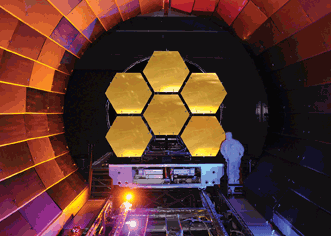
Ball Aerospace is responsible for design, manufacture, integration and test of JWST’s groundbreaking optics system. Photo courtesy of Ball Aerospace.
Advances in computing have allowed more detailed design and analysis predictions that are also more specific, and these advances are enabling new and increasingly complex systems, such as freeform optics and very lightweight, yet stiff, substrates. Instrumentation used for computing in optical processing steps has brought with it the development of tools that can be highly calibrated, leading to better optical surface quality.
“Accuracy of finished optical surfaces has significantly progressed [from] <λ/10 rms (visual limit at best), to now λ/100 for typical high-performance surface requirements,” Kaplan said.
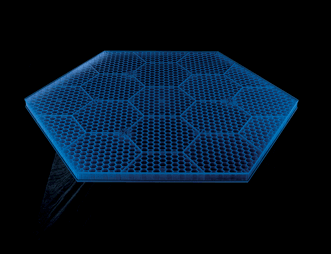
Proprietary proceses are used to create ultralightweight mirror structures from low thermal expansion materials. Photo courtesy of Exelis.
Over the past several decades, the optics industry has progressed in parallel with the computing and sensor industries, enabling developments in optical metrology systems, including interferometers, profilometers, laser trackers and phase-measuring microscopes. Optical measurements made for large data collection can be quickly and accurately reduced to provide feedback for fabrication processes.
A combination of manufacturing tools and technologies, advanced optical design code, and “out-of-the-box thinkers” can create new, enabling optical design and system capabilities. The advancement of freeform optics for the increased performance or reduced size and mass of space-based optical systems is a growing trend, too, according to Kevin Whiteaker, PhD, principal optical engineer at Ball Aerospace.
Modern optical tools are allowing increased access to system design processes. Traditional schooling taught very fundamental optical definitions and interactions between design features and their effects on aberrations and packaging. Today, schooling is providing such skills and knowledge, while advanced computing platforms are allowing scientists and researchers to employ more efficient design processes. Seminars and training programs, including those offered by SPIE and similar organizations, are boosting professional development.
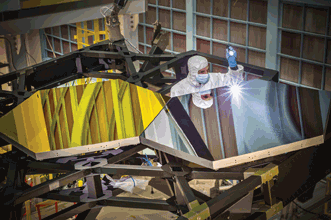
Larkin Carey, an optical engineer with Ball Aerospace, inspects primary mirror assemblies on JWST. Photo courtesy of Ball Aerospace.
Freeform optics allows designers the liberty to optimize their systems for cost, schedule reduction and enhanced performance.
“As the optical designers and manufacturers continue to learn how to leverage these capabilities, we will see many significant advancements over the next several years,” Mooney said.
The National Science Foundation’s Center for Freeform Optics (CeFO) – a cooperative research center that includes founding members Ball Aerospace, the University of Rochester in New York and the University of North Carolina at Charlotte – is advancing freeform optics in order to bring associated design tools, manufacturing and affordability levels to positions “similar to where axially symmetric aspheric optics are at today,” according to Whiteaker.
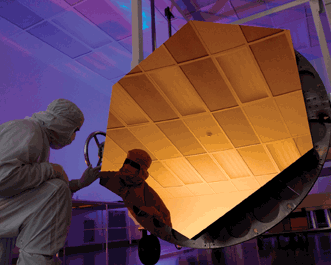
A Ball Aerospace optical technician inspects a JWST primary mirror segment’s 24-karat gold finish. Once in orbit, wavefront sensing and control software will calculate the optimum position of each mirror and then adjust positions to correct any errors. Photo courtesy of Ball Aerospace.
“This feeds the trend for more compact space systems with similar high performance in today’s larger spacecraft in the Earth-remote-sensing marketplace,” he said.
Significant advancements are also happening in optical components through the use of segmented and active apertures, insertion of enabling materials, precision replication technologies, and initial investigation into the utilization of additive manufacturing technologies.
Large-aperture membrane diffractive optics, free-space laser communications, and atmospheric laser remote detection for space-based sensors are other areas seeing progress, although they’re not ready for the market just yet.
“This is an innovative area of optics with a long history of studies and advances, but a lot of work is still needed
to advance the technology readiness levels,” Whiteaker said.
Precision optics
Space-based ventures such as the James Webb Space Telescope (JWST) – a large IR telescope with optical mirrors, set for launch in 2018 and developed via collaboration between NASA, the European Space Agency (ESA) and the Canadian Space Agency (CSA) – are demonstrating substantial advancement of space-based precision optics.
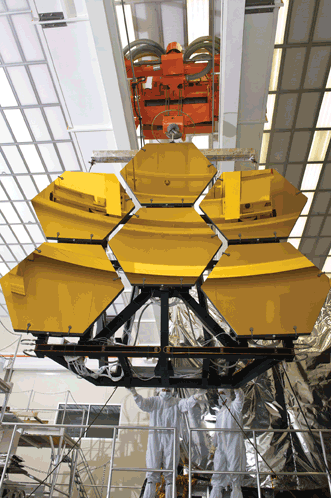
Part of the James Webb Space Telescope (JWST), six of the 18 primary mirrors installed on a thermal vacuum structure will be transported to NASA’s Marshall Space Flight Center in Huntsville, Ala. Photo courtesy of Ball Aerospace.
“This represents a significant step forward for space-based imaging capabilities,” Mooney said. “The recent growth in demand for small satellite imaging capabilities is also driving innovation for affordable, rapid deployment of space telescope capabilities.”
Exelis and Ball Aerospace are involved with the JWST project. Exelis will integrate components on JWST to form the optical telescope element that will collect light and provide sharp images of deep space, and perform optical tests at cryogenic temperatures to ensure that the optical telescope element will work properly. Ball has built the technology and mirror system at the core of the telescope, and is responsible for design, manufacture, integration and test of the optics system and its primary, secondary, tertiary and fine-steering mirrors.
Ground-based optics projects are also on the horizon. One in particular is the Large Synoptic Survey Telescope (LSST), which is expected to be fully operational in 2022. With a diameter of 8.4 m, the telescope will survey the entire visible sky deeply in multiple colors each week with a three-billion-pixel digital camera. The result will be a movie-like window on objects that change or move rapidly, such as exploding supernovae and near-Earth asteroids.
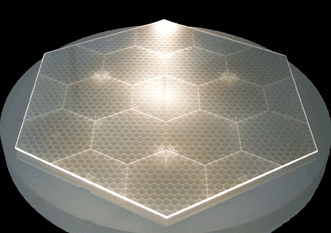
The Advanced Mirror System Demonstrator blank, comprising
19 ultralightweight core segments bonded to front and back plates, is
used to create ultralightweight mirror structures from low thermal
expansion materials. Photo courtesy of Exelis.
The Thirty Meter Telescope (TMT), currently in development by scientists from around the world at the TMT International Observatory LLC project office in California, is expected to become the most advanced and powerful optical telescope on Earth when completed in the mid-2020s. It should enable astronomers to study objects in our own solar system and stars, as well as in neighboring galaxies, and ultimately represents significant demand on the current precision optics industry. The European Extremely Large Telescope (E-ELT), scheduled for completion in 2024 at the European Southern Observatory headquartered in Germany, is another innovative ground-based optics project. With a 39-m main mirror, it is slated to become the largest optical, near-infrared telescope in the world.
Manufacturing and production
Space-product trends and technological advances are bringing with them lower mass solutions, faster solutions to support
small pixel scales, lower costs, and shorter development and manufacturing schedules, Kaplan said, as well as wider fields of view and diffraction-limited resolutions to support dense pixelated detectors for aspheric and freeform surfaces and other components.
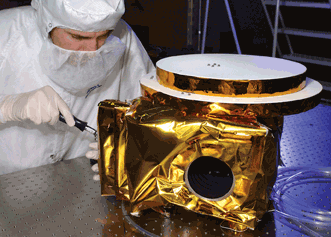
The Ralph Instrument for NASA's New Horizons Mission is shown infinal assembly at Ball Aerospace. Ralph, which uses only about seven watts of power (the same as a standard night light), will capture the first-ever images of Pluto in July 2015.
Significant improvements in design and production timelines are enabling faster processing steps. Another area of time improvement is additive manufacturing of mirror substrates (rather than machining, grinding, forming-assembling and molding), which is an “up-and-coming development process, though the surface will be processed by heritage approaches,” Kaplan said.
Many developers and manufacturers are seeking best-value solutions that balance cost, schedule and performance. There has been an overall increase in the number of commercial space initiatives, and these initiatives drive advances in optics performance.
“[There is] the opportunity for innovation not only in advancing system performance but also innovation in technologies that could provide significant reductions in cost and schedule, while still providing high-quality performance,” Mooney said.
Funding
For aerospace, space-based and related optics, government funding has been key, according to Ted Mooney, optical fabrication and testing engineering manager and chief engineer and strategist of precision optics at Exelis in McLean, Va.
Amid uncertain budgeting at the federal level, the National Research Council has called for improvements in observation, instrumentation and data management capabilities, as well as coordination among federal and private partners, to better position U.S. ground-based optical and IR astronomy systems to meet long-term scientific goals.
A new report by the council calls for continued government funding of astronomer training and telescope construction. It also recommends that the National Science Foundation continue to invest in the development of a number of critical instrument technologies, such as adaptive and active optics.
In the future, the report said, the National Science Foundation should plan to invest in one or both of the giant segmented-mirror telescopes (GSMTs) that are expected to become operational within the next 10 years. These will explore the physics of planet formation, the growth of black holes and the advent of the first galaxies.